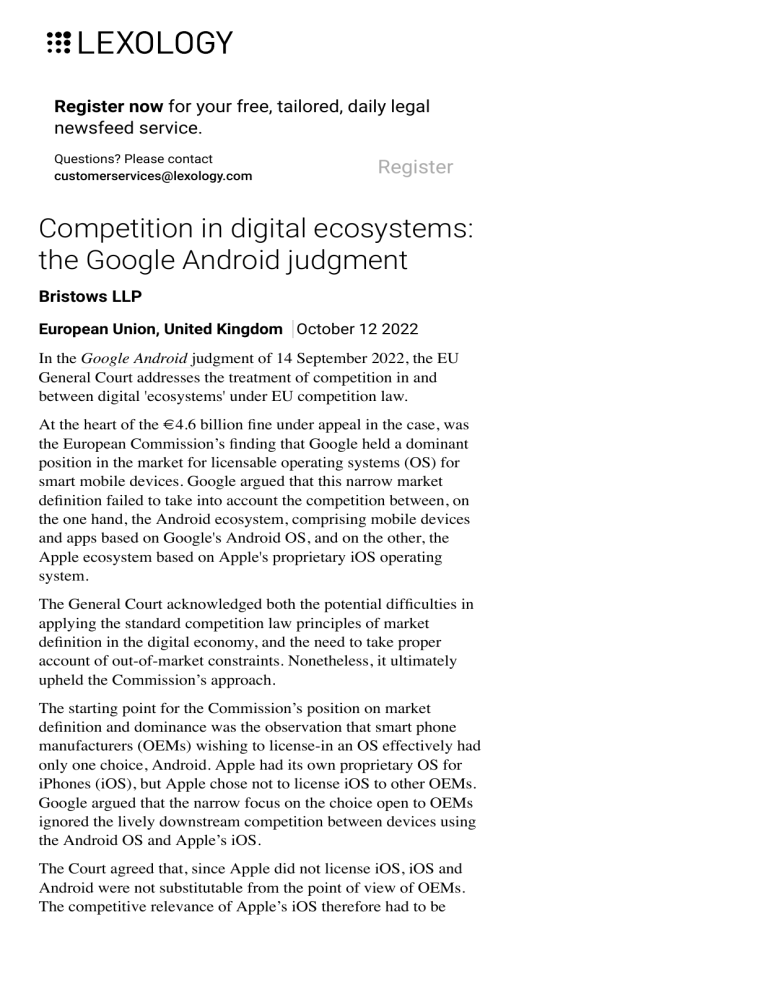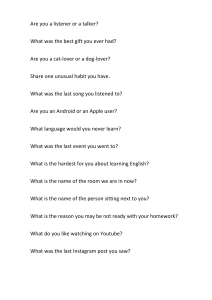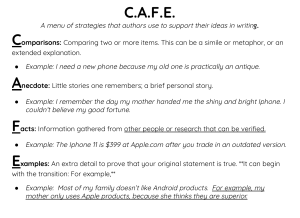Competition in digital ecosystems the Google Android judgment - Lexology
advertisement

Register now for your free, tailored, daily legal newsfeed service. Questions? Please contact customerservices@lexology.com Register Competition in digital ecosystems: the Google Android judgment Bristows LLP European Union, United Kingdom October 12 2022 In the Google Android judgment of 14 September 2022, the EU General Court addresses the treatment of competition in and between digital 'ecosystems' under EU competition law. At the heart of the €4.6 billion fine under appeal in the case, was the European Commission’s finding that Google held a dominant position in the market for licensable operating systems (OS) for smart mobile devices. Google argued that this narrow market definition failed to take into account the competition between, on the one hand, the Android ecosystem, comprising mobile devices and apps based on Google's Android OS, and on the other, the Apple ecosystem based on Apple's proprietary iOS operating system. The General Court acknowledged both the potential difficulties in applying the standard competition law principles of market definition in the digital economy, and the need to take proper account of out-of-market constraints. Nonetheless, it ultimately upheld the Commission’s approach. The starting point for the Commission’s position on market definition and dominance was the observation that smart phone manufacturers (OEMs) wishing to license-in an OS effectively had only one choice, Android. Apple had its own proprietary OS for iPhones (iOS), but Apple chose not to license iOS to other OEMs. Google argued that the narrow focus on the choice open to OEMs ignored the lively downstream competition between devices using the Android OS and Apple’s iOS. The Court agreed that, since Apple did not license iOS, iOS and Android were not substitutable from the point of view of OEMs. The competitive relevance of Apple’s iOS therefore had to be assessed at the level of the downstream markets for phone users and app developers. As regards users, the Court found that users’ choice between ecosystems was based on multiple factors and could not be reduced to the OS alone. The OS was an important factor in the choice of a smart phone, but not the only factor. Switching between ecosystems was prompted mainly by new device launches, not OS changes. Android users did show significant loyalty to the Android ecosystem: 82% declined to switch to Apple when purchasing a new device in 2015. But that loyalty did not appear to be driven by the quality of the OS. Figures for May 2017 showed that only 7.1% of Android users were running the latest version of the Android OS on their devices, six months after it had become available. Similarly, only a very small proportion of users that had switched to an Apple device said they had done so due to OS quality. Instead, user loyalty could be attributable to the difficulties encountered when switching ecosystems, for example in porting personal data, having to repurchase apps, or having to relearn the way their device works. The fact that Apple had launched an app to facilitate the move from Android to iOS tended to show that switching costs were a concern. For users of lower-end devices, Apple’s pricing policy also appeared to operate as an obstacle to switching, with at least 50% of Android devices being sold at prices below those of Apple devices. As regards a possible constraint from app developers, the Court found that to the extent users were unlikely to switch to another mobile OS, the same would be true of app developers, who could not reasonably abandon the majority of their customers. Overall, the Court concluded the Commission had been justified in treating the Apple ecosystem as an “indirect constraint” on Google and finding that constraint was insufficient to call Google’s dominance into question. In assessing the significance of the constraint, the Commission examined the likelihood that users (and app developers) would switch in response to a small but significant non-transitory reduction in quality (SSNDQ). This is different from the traditional small but significant non-transitory increase in price (SSNIP) test. However, the Court upheld the approach. Competition can take place in terms of quality and innovation as well as in terms of price. And this was a case of a product unlikely to lend itself to a traditional, price-based, SSNIP test. Indeed, Google appears to have argued that, for an OS, quality was the determining factor in consumer choice. Conclusions and comments In this, as in all cases, the outcome on market definition and dominance was highly fact dependent. However, for those considering how to treat competition between digital ecosystems – or even more traditional fore- and after-market systems like razors and razor blades or copiers and toner cartridges – the approach of the General Court seems instructive. The Court was quick to define separate markets at the OEM and user levels. It then asked whether the competition taking place at the user level was driven only (or at least very largely) by OS quality. Once the Court had determined that multiple factors, including but not limited to OS quality, were relevant to user choice, Google was facing an uphill battle to demonstrate that the indirect constraint from Apple was sufficient to avoid a finding of dominance. within the digital economy... traditional parameters such as the price of products or services or the market share of the undertaking concerned may be less important curia.europa.eu/... Bristows LLP - Sean-Paul Brankin



